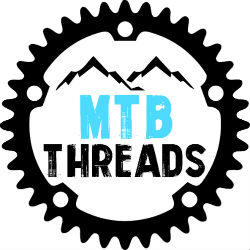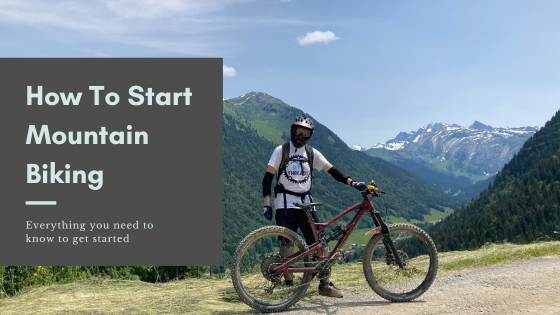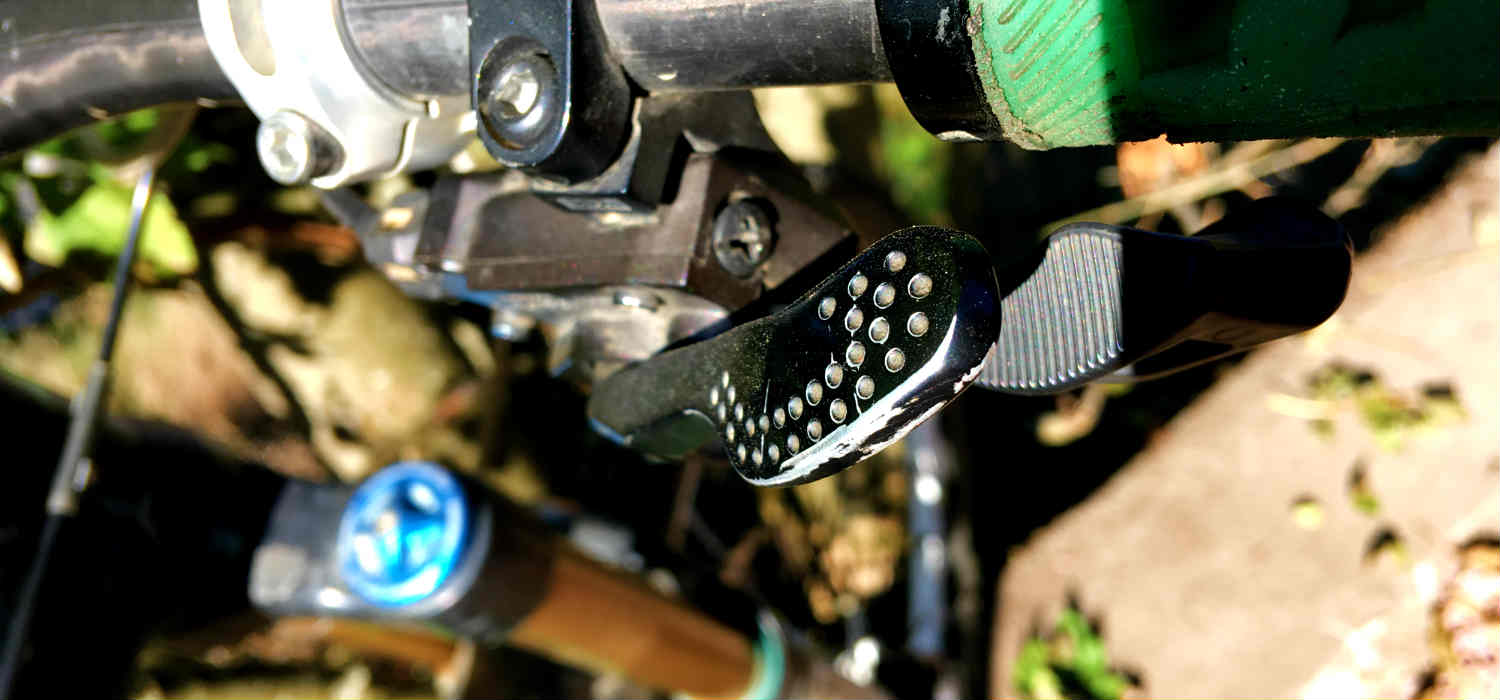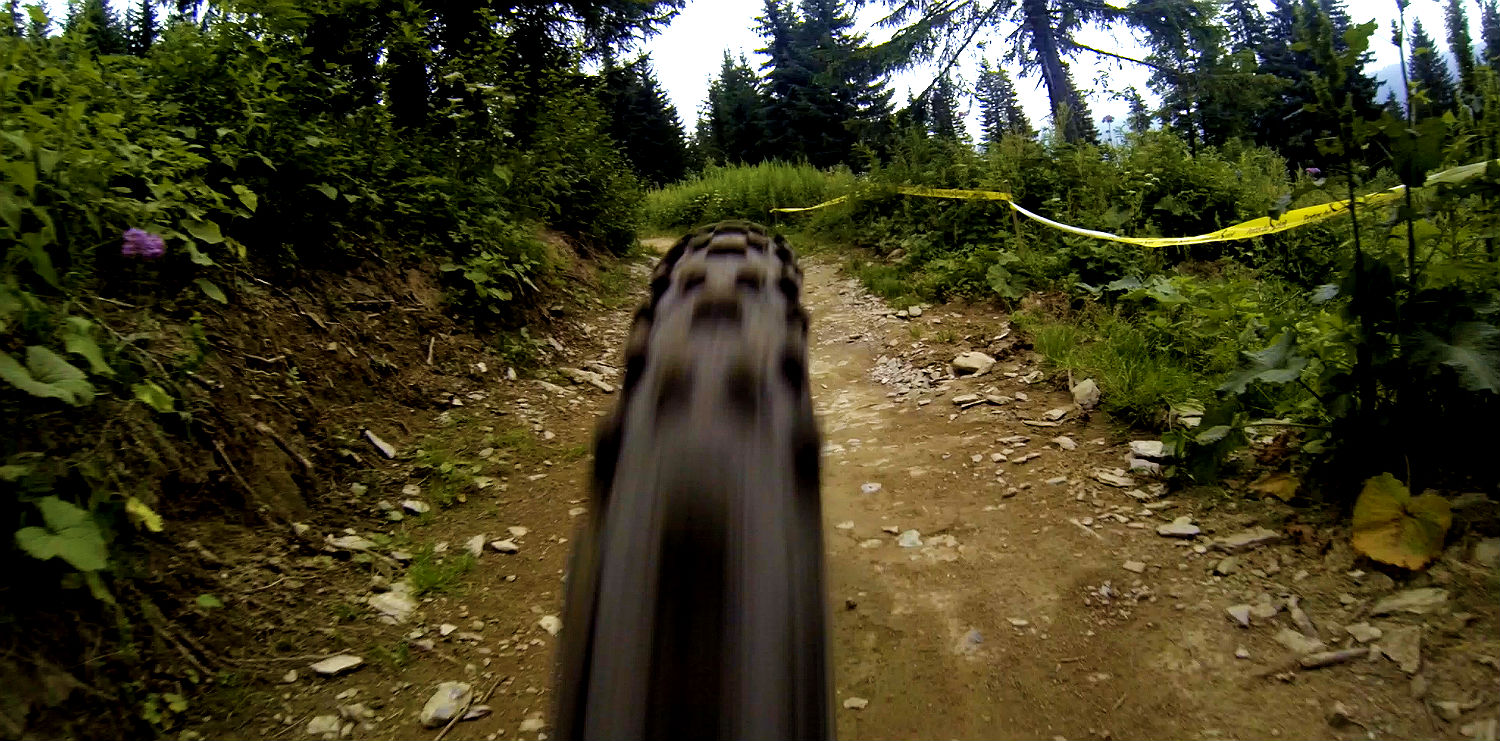How To Start Mountain Biking
Mountain biking is incredibly rewarding; it’s fun and good for your body and mind. So, I decided to write a blog giving you lots of tips on how to start mountain biking.
You’ll learn about the various types of mountain biking, the gear you’ll need, and everything you need to know to get started.
Starting Mountain Biking From Scratch
When you can see the potential of what a mountain bike can give you, it’s no wonder why so many people want to know how to start mountain biking. My bike has taken me to some of the most incredible views in the world, given me a healthy dose of adrenaline, and improved my fitness. I can confidently say riding my bike has changed my life.
However, getting into mountain biking can be confusing and intimidating. I picked up a few things from reading magazines and taking the odd lesson in the early days. But, after moving to the French Alps, I soon realized that riding here was a whole new ball game. Luckily, I had the guidance of some experienced riders, but I learned most of what I know from just doing it.
My change in circumstances taught me a lot about mountain biking. I learned about the different bikes, what they’re used for, what I needed to wear, and how to stay safe.
Looking back at old photos, I looked like a complete Jerry, even though I thought I looked the part, and that’s without scrutinizing my riding skills. Don’t get me wrong, I’m not some super-skilled mountain biker, and there will always be something to learn. But I love it and enjoy sharing my knowledge with new riders.
With this blog, I aim to give you a head start and take out some trial and error. But you must understand that mountain biking has a learning curve that takes time to get over. You will get scared and fall off your bike occasionally, but you must prepare for and accept this. But keep reading, and you’ll learn how to minimize these incidents and manage risk.
What Is Mountain Biking?
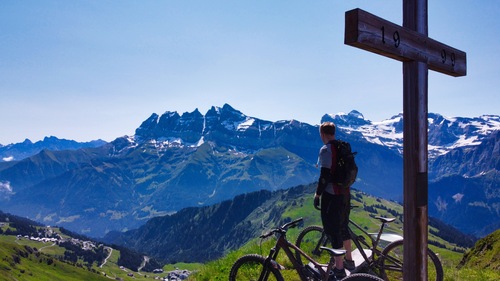
Let’s start with the basics. Mountain biking is riding a bike off-road and originated in California in the 1980s. Those early pioneers fitted their regular bikes with tough wheels and tires so they could charge down steep and rocky mountainous paths, often illegally.
The sport has evolved considerably since then. We now have high-tech bikes, expertly built trails, and refined MTB skills. We also benefit from advanced protection in the form of body armor and helmets.
Trails are much easier to access, too. For example, there are many dedicated mountain bike trail centers. Ski resorts also switch on their ski lifts during summer to carry us to the tops of mountains, and electric bikes are changing everything.
These innovations have increased mountain biking’s popularity. But there are a few different types of mountain biking you need to know about:
1. Cross-country
Cross-country mountain biking takes place on relatively mellow terrain, making it one of the most accessible mountain bike disciplines. Cross-country rides are more about long-distance pedals rather than adrenaline-fuelled technical rides.
The nature of cross-country mountain biking means cross-country bikes are relatively simple. The bike’s designs make them efficient to pedal and minimalist. By this, I mean most cross-country bikes are hardtails (bikes with no suspension on the rear wheel), but you will come across higher-end full-suspension cross-country bikes.
Another reason many beginner mountain bikers start with cross-country is that the terrain is pretty easy to ride. Therefore, you don’t need a high skill level to navigate the trails. Cross-country mountain biking is excellent for fitness and developing MTB skills.
Learn more about the characteristics of a cross-country mountain bike here.
2. Trail Riding
Trail riding is the most popular kind of mountain biking, as it offers riders the most variety. You can ride a trail bike on singletrack, through forests, or in a bike park, as they can come with most terrain types.
Trail bikes are the Swiss army knife of mountain biking. A good one should allow you to cope with most trails without feeling overwhelmed. There is a limit to a trail bike’s ability, but they are suitable for most people and are the most fun to ride.
3. Enduro
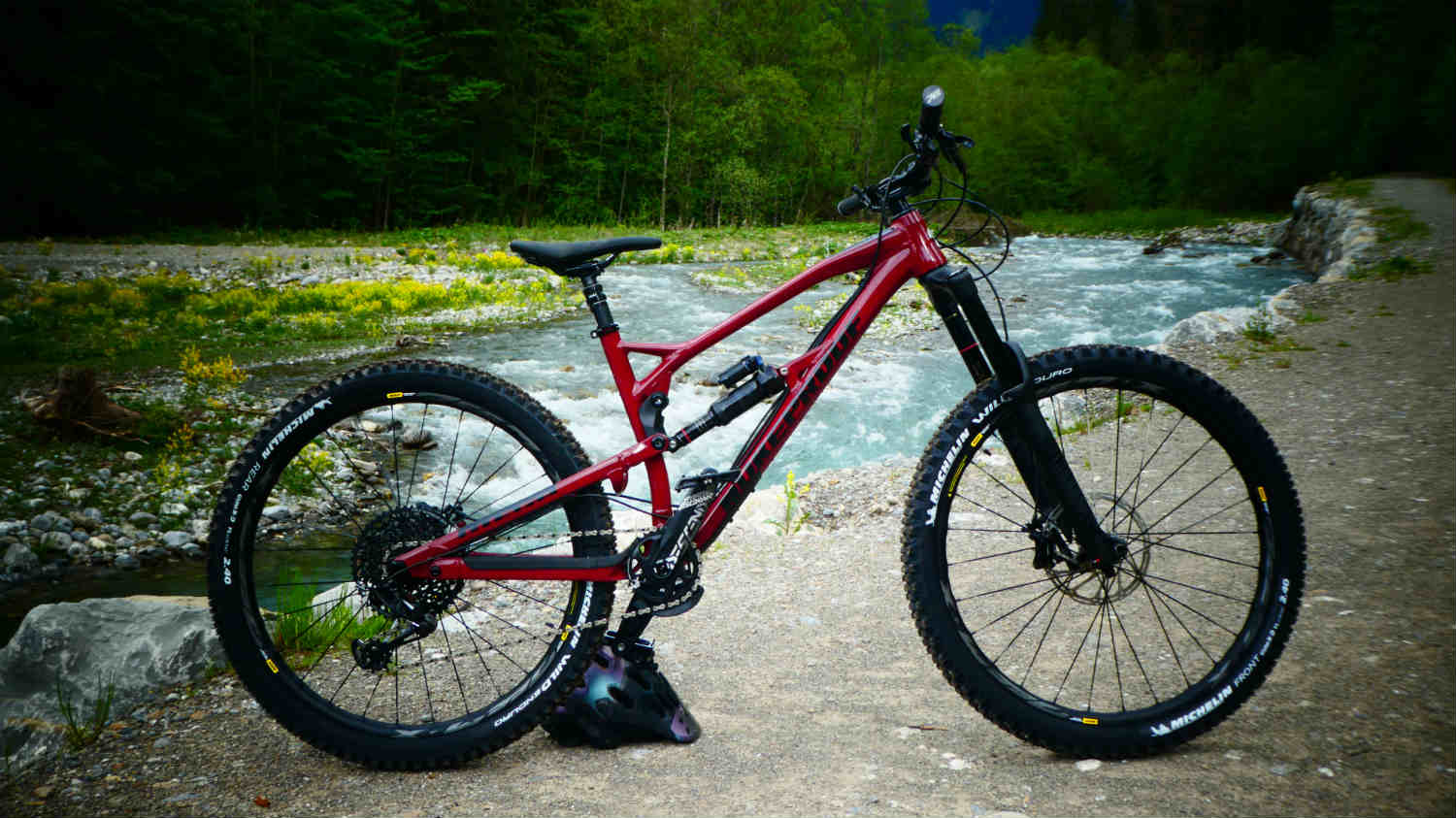
Enduro mountain bikes are like trail bikes on steroids. They have lots of suspension travel, and their frame geometry makes them more capable of coping with extremely rough and steep terrain. Enduro mountain bikes are designed to be pedaled up a mountain and tackle anything you encounter on the descent.
I ride an enduro mountain bike, as it suits the local alpine terrain. I can use it on technical natural trails and lift-assisted bike park runs.
Learn more about the characteristics of an enduro bike here.
4. Downhill Mountain Biking
As the name suggests, downhill mountain biking involves charging down a mountain as fast as possible. Downhill mountain bikes are heavy and burly, so they can cope with aggressive riding and terrain.
They have long suspension travel to soak up the impacts of jumps and drops. The added advantage of their suspension design is that it smooths out the ride, allowing you to ride faster.
You won’t see many people riding a downhill bike uphill. Their weight makes it challenging, and their gearing is optimized for downhill acceleration.
I wouldn’t recommend a downhill bike as a beginner. It is best to build mountain bike skills before jumping on one of these beasts.
Learn more about the characteristics of a downhill mountain bike here.
Full-Suspension vs. Hardtail
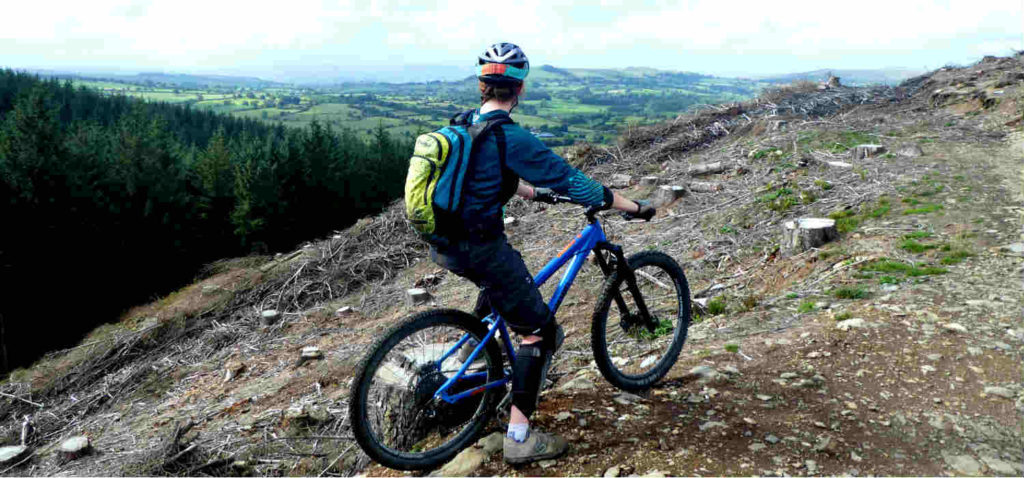
You’ll find that cross-country and trail bikes come as hardtails or full-suspension bikes. Both have their advantages and disadvantages:
A full-suspension bike has a suspension fork and a shock absorber mounted to the rear triangle. This improves grip on the trail and soaks up the bumps for a faster and more comfortable ride. These bikes are fantastic but more expensive and require more maintenance.
Hardtails are less capable but lots of fun to ride. They are also more efficient, as the rear doesn’t bob up and down as you pedal.
I recommend that you start with a hardtail mountain bike. They are cheaper to buy, easier to look after, and help you to learn essential mountain bike skills.
Check out my blog, Full-Suspension vs. Hardtail, for the complete story
Mountain Bike Wheel Sizes
As a beginner, you’ll probably opt for a cross-country or trail bike. But you need to know about the various wheel sizes available.
26"
26″ wheels are getting rare now, but you’ll find older mountain bikes and dirt jump bikes fitted with them. 26ers provide fast acceleration and agile handling. The downsides of this size are that it takes more effort to maintain your speed, and their ride quality isn’t as smooth as larger wheels.
If you buy a used bike with 26″ wheels, it will be a great price. However, it is becoming more challenging to find good tires for them.
27.5"/650b
27.5″ wheels are also classed as 650b and offer a smoother ride than 26ers. Many regard this wheel size as the sweet spot, giving you responsive handling and a smooth ride.
Many mountain bike manufacturers are shying away from 27.5″ wheels in favor of 29ers. Which is a shame, as I prefer 27.5″ wheels as they suit my size, and I like their handling characteristics.
29"
29″ wheels provide more speed and stability. They also roll over rocks better than smaller wheels, improving efficiency and ride quality. However, the compromise of 29ers is that you lose agility in the corners.
My electric mountain bike has 29″ wheels, so I must adapt my riding to suit.
Mixed Wheel Bikes
You will also come across bikes with a 29″ wheel at the front and a 27.5″ wheel at the back. Affectionately called mullet bikes, they give you agility at the rear and smoothness up front.
Mountain Bike Frame Materials
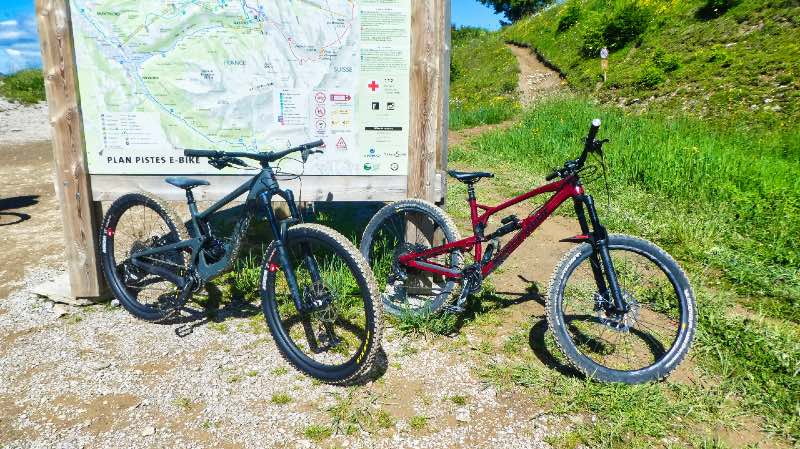
The next thing you must consider when choosing a mountain bike is its frame material. Most mountain bike frames are made from aluminium or carbon; both have their qualities.
Carbon mountain bikes are more expensive than aluminium bikes but are lighter and stronger. As a beginner, I recommend you choose an aluminum bike. The damage will be easier to swallow if and when you crash it. Also, aluminium frames dent rather than crack when they receive significant impacts. This means you should at least be able to ride home as long as you’re fully functioning.
However, you may have money to burn. If so, there’s nothing wrong with treating yourself.
Where To Buy Mountain Bikes
You can’t beat the advice and customer service you get from a local bike shop. However, you’ll pay more for a bike in a shop than online and have less variety. So, as long as you do plenty of research, you’ll be able to find the right bike online, often at a heavily discounted price. Here are a few places you can buy a mountain bike online:
What To Wear Mountain Biking
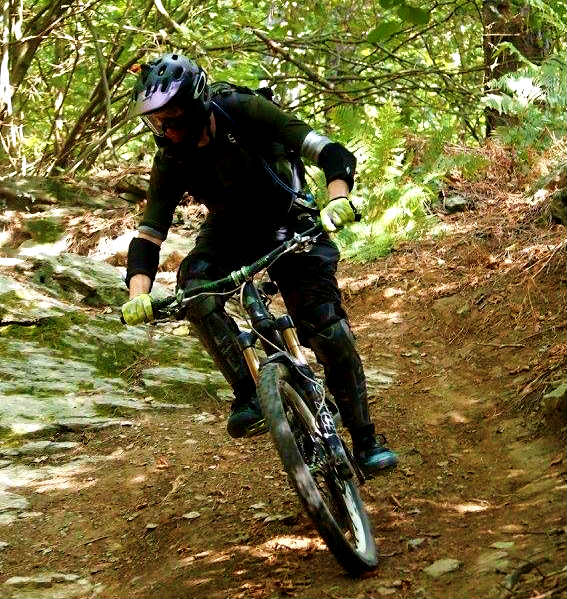
Mountain biking requires the correct clothing and quite a few accessories. Below, I’ll list everything you need as a mountain biker. You may think this is a lot of stuff that will cost lots of money, and you’d be right. But you don’t need to buy everything at once. Most people collect this stuff over time, but the essential thing you need to buy is a helmet.
Clothing
You may be tempted to throw on an old T-shirt and shorts for mountain biking. But this isn’t the best idea, as they are not made from fabrics suitable for mountain biking. Proper mountain bike clothing is made from technical fabrics that wick moisture away from your skin. They also dry quickly, helping you regulate your body temperature to stay comfortable.
Check out my detailed blog to learn all about mountain bike clothing.
Protection
Mountain biking comes with hazards, and let’s face it, there are more comfortable things to crash into than rocks and trees. But we can protect ourselves with the right equipment.
Nobody should mountain bike without a helmet, even if you’re just working on low-speed skills around a car park. But you need to get the right helmet, so I advise you to check out my guide to mountain bike helmets.
I always ride wearing knee and elbow pads. They have saved my bony joints on many occasions when my bike unexpectedly went one way, and I went the other.
These are the pads I currently ride with:
But you may want to check out my buyer’s guides:
Mountain Bike Shoes
Mountain bike shoes are not essential in the early days. You can ride in flat shoes, such as skate shoes. But as you progress, you’ll want the grip and comfort a good pair of mountain bike shoes provide.
I have written several blogs on mountain bike shoes with buyer’s guides and recommendations. Click here to check them out.
What Mountain Bike Kit Do You Need?
Mountain biking requires a few things that enhance your time on the bike, keep you safe, and riding for longer. Some are more essential than others, so let’s get into them:
Backpack, Hydration Pack, or Hip Pack
When you’re out in the middle of nowhere, hungry, thirsty, or with a broken bike, you’re not going to have the best day. Therefore, I recommend riding with a backpack, hydration pack, or hip pack.
These are ideal for carrying your stuff, such as food, drink, inner tube, pump, tire levers, tools, etc. Which you choose depends on your circumstances and preferences.
A backpack is best for longer days and when you need more stuff. I wear a backpack most days, as I carry camera equipment and a drone, along with my multitool and spare inner tube, etc. But I’ll wear a hip pack on a local fitness ride. Hip packs are great, as they are minimalist but have just enough room for a water bottle and a few other essentials. Another advantage of hip packs is that you don’t get a sweaty back.
Hydration packs are usually more slimline than a traditional mountain bike backpack. Still, they have plenty of clever compartments to carry what you need for the day while concealing a handy hydration bladder for sipping drinks on the move.
Some backpacks and hydration packs have built-in back protectors. These give you more confidence on the trails and peace of mind if you crash.
Tools
It’s a fact that bikes break, and it’s hardly surprising when you consider the punishment they take. Therefore, it’s best to carry a few essential tools. I like to bring the following:
Inner tube: Even when I ride tubeless, I always carry a spare inner tube. Sometimes, damage to a tire can be so severe tubeless sealant isn’t enough to keep it inflated. So, having a spare inner tube will allow you to keep riding if you get a puncture.
Tire Levers and Pump: If you don’t have tire levers and a pump, you won’t be able to fix a puncture on the trail. This is incredibly annoying when you’re miles away from home or a bike shop.
Multitool: A multitool is excellent for making minor trailside repairs. They feature a selection of tools that will get you back on your bike, even temporarily. Here is what you need to look out for when buying a mountain bike multitool.
Where To Ride
Let’s take a break from the long list of stuff you need to talk about places to ride. The great thing about mountain bikes is that you can ride them on any terrain. So, nothing stops you from going for a pedal right from home.
However, mountain bikes are built for exploring and riding rugged and entertaining terrain. So, where are the best places to ride?
Head To A Mountain Bike Trail Center
Mountain bike trail centers have purpose-built and maintained trails. They are usually set in forests and are excellent places to cut your teeth in the mountain bike world.
Trails are often rated according to their difficulty, like ski slopes:
Green: Super easy and usually flat, suitable for kids and families
Blue: A little more challenging but way more fun
Red: Best suited to intermediate riders
Black: Expert only
Beginners should start with green and blue trails. Try a red trail once you’ve built up some skills and confidence.
Head To A Ski Resort
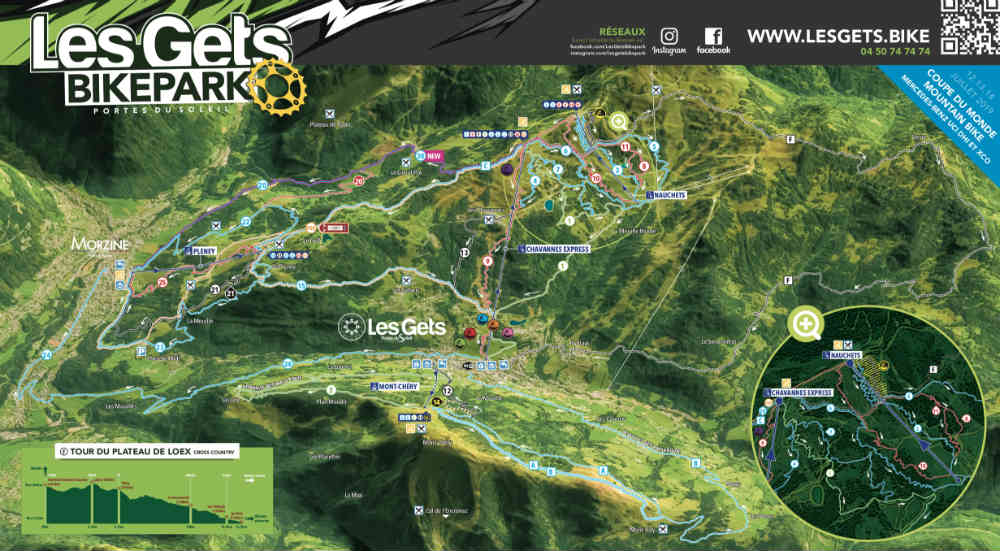
Many ski resorts turn into mountain bike destinations in the summer, as you can use the ski lifts to get to the top of the trails. Riding in the mountains is an incredible experience, with world-class trails and stunning views as your backdrop.
However, mountain biking in ski resorts should not be taken lightly. Mountains are big and steep, and the trails are often highly technical, especially for beginners. You will find suitable trails for your skill level in some ski resorts, but I advise you to do your homework before you book a trip so you don’t get out of your depth.
It may be best to pick up the basics at a trail center before heading to a ski resort. Alternatively, why not book a coaching session so an instructor can look after you and take you to the best parts of the mountain?
A note on electric mountain bikes –
Electric mountain bikes are superb for many reasons. Some people hire them to ride in ski resorts; there’s nothing wrong with this as long as you use them correctly.
If you plan on riding downhill trails, you don’t need an electric bike, as you will use the ski lifts. I’ve seen many inexperienced people struggle to handle their rental ebike on downhill trails. The motor helps you pedal but doesn’t give you mountain bike skills, which is more critical on downhill trails.
Electric mountain bikes are great for exploring away from man-made trails. So, if you want to ride an electric mountain bike in a ski resort, look for enduro routes suitable for your ability. But be careful, as you can get into trouble if you end up miles away up a mountain with no battery power left
Use Apps And Websites
There are a few apps and websites that make looking for trails super easy. I like to use Strava’s heatmap function. It shows where people have been riding, so you can get a good idea of popular routes. However, it doesn’t tell you how difficult these routes are, so you need good local knowledge.
An alternative app/website is Kommoot. Kommoot features rider’s accounts and photos of each route. This is an invaluable feature as you can tell how long it usually takes, what to look for, and if the route suits your ability. On top of this, people often tell you the best places to go for lunch!
Ride With Friends
Going somewhere new is one of the best things about mountain biking. So, if you can ride with someone with local knowledge, you can learn about new trails. If your friend is more experienced, they can also give you some pointers.
Go To A Bike Shop
When visiting a new place, find a local bike shop. The people who work there can advise you on local beginner-friendly trails. They may even have local maps to help you navigate.
What To Expect From A Mountain Bike Trail
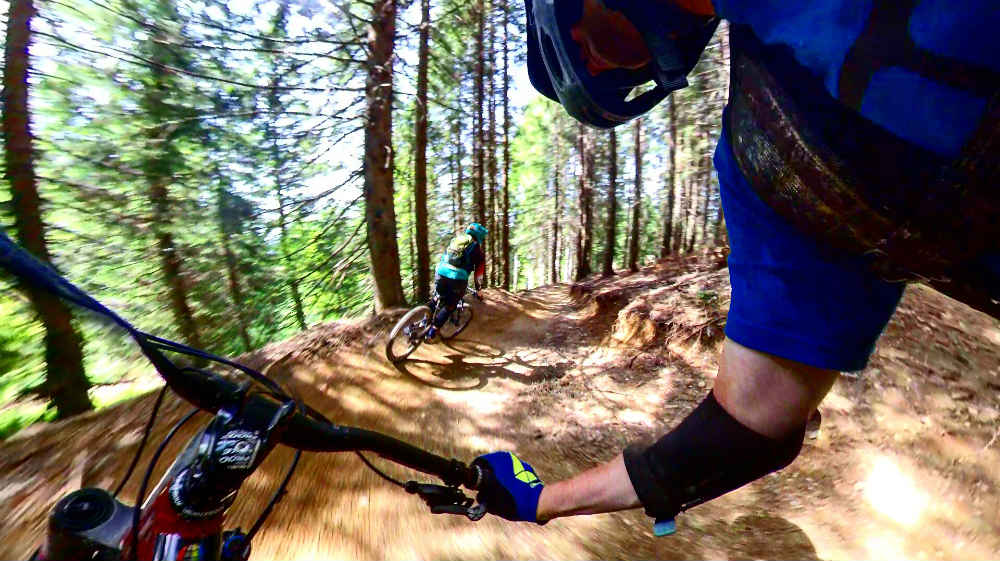
I’ve already touched on how mountain bike trails are graded, but everywhere is different. A blue trail in one location may be more or less difficult than a blue you’re used to riding. However, there are common things you will encounter:
Berms
A berm is a banked corner. Trail builders shape the corners like this so you can take them at higher speeds. Some berms are smaller than others, and there’s a specific technique to riding them well. Berms are fun to ride but become even more entertaining when you use them correctly.
Rock Gardens
Rock gardens are rocky patches you’ll encounter on a trail. The rock gardens on easy trails are no rougher than a cobbled street but expect extremely technical ones on more challenging trails.
Table Tops
A table top is a jump with a flat section in the middle. They are designed so you can roll or jump over the flat section. Table tops are excellent for jump practice and become incredibly satisfying when you begin to clear them.
Drops
Drops can be artificial or natural step-downs. They are often big enough that both your wheels leave the ground. However, some are small enough to roll down.
Gaps/Doubles
It would be best if you avoided gaps as a beginner. These are jumps that require you to take off over a gap and land on the other side. It doesn’t take a genius to work out what happens if you don’t take off with enough speed.
Trails suitable for beginners shouldn’t have too many of these features. If they do, they will be mellow and have “chicken lines,” which allow you to avoid anything too technical and dangerous.
Preparing For Your First Ride
Before heading to the trails, you must ensure you’re fully prepared. Here’s what you need to do:
Plan A Route
Find a suitable route for your ability and understand how long it should take you. Letting someone know your plans before you set off is also a good idea. I recommend sticking to popular routes if you’re a complete novice.
Prepare Your Bike
It’s frustrating when something goes wrong with your bike during a ride. Therefore, lubricate your bike chain, check tire pressures, and ensure all your bike’s bolts are nice and tight. It’s important to not overtighten bolts, as this can lead to more severe problems.
Pack Your Bag
Remember to pack your spare inner tube, tire levers, pump, and multitool. You must also ensure you have enough food and water for your ride.
Consider Mountain Bike Lessons
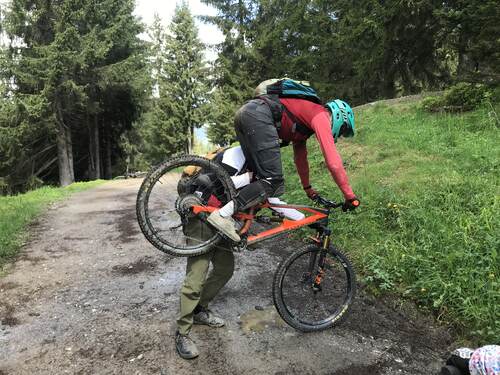
You’ll benefit from a coaching session if you are new to mountain biking. I wish I’d done more of this in the early days, as I know I would have benefited from some pointers.
Mountain bike coaching sessions give you the basic skills to take to the trails. They make your learning curve much easier to manage and improve your riding quicker than if you were to just hit the trails without any instruction.
Check out my blog on what I got out of taking a few mountain bike lessons this summer.
How To Get Your Bike To The Trails
I’m lucky enough to live in a ski resort in France, so I can quickly access trails in the summer. But not everyone has this luxury, so how can you get your bike to the trails if they are far away?
The most convenient way to get your bike to the trails is by car. If your car is too small for a bike, try removing the front wheel to make it fit. If this doesn’t work, you’ll need some kind of bike rack. There are quite a few different types to choose from depending on your needs, budget, and vehicle. So, check out my guide to bike racks for the complete rundown.
Final Thoughts On How To Start Mountain Biking
All this information on how to start mountain biking may seem overwhelming. But I’ve tried to make this blog as comprehensive as possible, to leave no stone unturned.
It’s important to remember that you don’t need to buy everything straight away. As long as you have what you need to stay safe and comfortable, you’re good to go; everything else will come over time.
If you have any questions or thoughts on how to start mountain biking, please leave them in the comments section below. You can also contact me through my Instagram.
